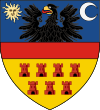Erdély
|
Transylvania Transilvania/Ardeal (in Romanian) Erdély (in Hungarian) Siebenbürgen (in German) |
||
|---|---|---|
| Historical region of Romania | ||

|
||
|
||
| Nickname(s): "The Land Beyond the Forest" | ||
 Transylvania proper
|
||
| Coordinates: 46°46′0″N 23°35′0″E / 46.76667°N 23.58333°ECoordinates: 46°46′0″N 23°35′0″E / 46.76667°N 23.58333°E | ||
| Country |
|
|
| Area | ||
| • Total | 102,834 km2 (39,704 sq mi) | |
| Population (2011) | ||
| • Total | 7,309,291 | |
| • Density | 71/km2 (180/sq mi) | |
| Demonym(s) | Transylvanian | |
| Time zone | EET (UTC+2) | |
| • Summer (DST) | EEST (UTC+3) | |
Transylvania is a historical region located in what is today the central part of Romania. Bound on the east and south by its natural borders, the Carpathian mountain range, historical Transylvania extended westward to the Apuseni Mountains. The term sometimes encompasses not only Transylvania proper, but also the historical regions of Crișana and Maramureș, and occasionally the Romanian part of Banat.
The region of Transylvania is known for the scenery of its Carpathian landscape and its rich history. It also contains major cities such as Cluj-Napoca, Brașov, Sibiu and Târgu Mureș.
In the English-speaking world it has been commonly associated with vampires, due to the influence of Bram Stoker's novel Dracula and its many film adaptations.
Historical names of Transylvania are:
In Romanian, the region is known as Ardeal (pronounced [arˈde̯al]) or Transilvania (pronounced [transilˈvani.a]); in Hungarian as Erdély (pronounced [ɛrdeːj]); in German as Siebenbürgen (pronounced [ˈziːbn̩ˌbʏʁɡn̩]); and in Turkish as Transilvanya (pronounced [tɾansilˈvanja]) but historically as Erdel or Erdelistan; see also other denominations.
...
Wikipedia

